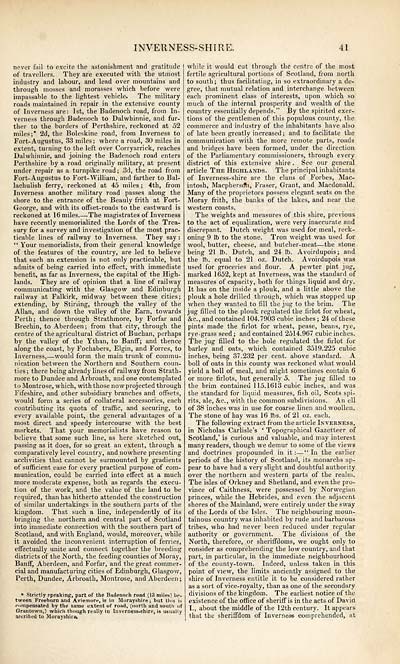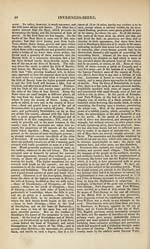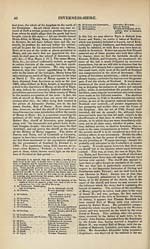Download files
Complete book:
Individual page:
Thumbnail gallery: Grid view | List view

INVERNESS-SHIRE.
41
never fail to excite the astonishment and gratitude
of travellers. They are executed with the utmost
industry and lahour, and lead over mountains and
through mosses and morasses which before were
impassable to the lightest vehicle. The military
roads maintained in repair in the extensive county
of Inverness are: 1st, the Badenoch road, from In-
verness through Badenoch to Dalwhinnie, and fur-
ther to the borders of Perthshire, reckoned at 52
miles;* 2d, the Boleskine road, from Inverness to
Fort- Augustus, 38 miles; where a road, 30 miles in
extent, turning to the left over Corryarrick, reaches
Dalwhinnie, and joining the Badenoch road enters
Perthshire by a road originally military, at present
under repair as a turnpike road; 3d, the road from
Fort-Augustus to Fort- William, and farther to Bal-
lachulish ferry, reckoned at 45 miles ; 4th, from
Inverness another military road passes along the
shore to the entrance of the Beauly frith at Fort-
George, and with its offset-roads to the eastward is
reckoned at 16 miles The magistrates of Inverness
have recently memorialized the Lords of the Trea-
sury for a survey and investigation of the most prac-
ticable lines of railway to Inverness. They say :
" Your memorialists, from their general knowledge
of the features of the country, are led to believe
that such an extension is not only practicable, but
admits of being carried into effect, with immediate
benefit, as far as Inverness, the capital of the High-
lands. They are of opinion that a line of railway
communicating with the Glasgow and Edinburgh
railway at Falkirk, midway between these cities;
extending, by Stirling, through the valley of the
Allan, and down the valley of the Earn, towards
Perth; thence through Strathmore, by Forfar and
Brechin, to Aberdeen; from that city, through the
centre of the agricultural district of Buchan, perhaps
by the valley of the Ythan, to Banff; and thence
along the coast, by Fochabers, Elgin, and Forres, to
Inverness, — would form the main trunk of commu-
nication between the Northern and Southern coun-
ties; there being already lines of railway from Strath-
more to Dundee and Arbroath, and one contemplated
to Montrose, which, with those now projected through
Fifeshire, and other subsidiary branches and offsets,
would form a series of collateral accessories, each
contributing its quota of traffic, and securing, to
every available point, the general advantages of a
most direct and speedy intercourse with the best
markets. That your memorialists have reason to
believe that some such line, as here sketched out,
passing as it does, for so great an extent, through a
comparatively level country, and nowhere presenting
acclivities that cannot be surmounted by gradients
of sufficient ease for every practical purpose of com-
munication, could be carried into effect at a much
more moderate expense, both as regards the execu-
tion of the work, and the value of the land to be
required, than has hitherto attended the construction
of similar undertakings in the southern parts of the
kingdom. That such a line, independently of its
bringing the northern and central part of Scotland
into immediate connection with the southern part of
Scotland, and with England, would, moreover, while
it avoided the inconvenient interruption of ferries,
effectually unite and connect together the breeding
districts of the North, the feeding counties of Moray,
Banff, Aberdeen, and Forfar, and the great commer-
cial and manufacturing cities of Edinburgh, Glasgow,
Perth, Dundee, Arbroath, Montrose, and Aberdeen ;
* Strictly speaking, part of the Badenoch road (13 miles) be-
tween Freeburn and Aviemore, is in Morayshire; but this is
compensated by the same extent of road, (north and south of
Grantown,) which though really in Inverness-shire, is usually
ascribed to Morayshire,
while it would cut through the centre of the most
fertile agricultural portions of Scotland, from north
to south ; thus facilitating, in so extraordinary a de-
gree, that mutual relation and interchange between
each prominent class of interests, upon which so
much of the internal prosperity and wealth of the
country essentially depends." By the spirited exer-
tions of the gentlemen of this populous county, the
commerce and industry of the inhabitants have also
of late been greatly increased ; and to facilitate the
communication with the more remote parts, roads
and bridges have been formed, under the direction
of the Parliamentary commissioners, through every
district of this extensive shire . See our general
article The Highlands. The principal inhabitants
of Inverness-shire are the clans of Forbes, Mac-
intosh, Maepherscti, Fraser, Grant, and Macdonald.
Many of the proprietors possess elegant seats on the
Moray frith, the banks of the lakes, and near the
western coasts.
The weights and measures of this shire, previous
to the act of equalization, were very inaccurate and
discrepant. Dutch weight was used for meal, reck-
oning 9 lb to the stone. Tron weight was used for
wool, butter, cheese, and butcher-meat; — the stone
being 21 lb. Dutch, and 24 lb. Avoirdupois; and
the lb. equal to 21 oz. Dutch. Avoirdupois was
used for groceries and flour. A pewter pint jug,
marked 1652, kept at Inverness, was the standard of
measures of capacity, both for things liquid and dry.
It has on the inside a plouk, and a little above the
plouk a hole drilled through, which was stopped up
when they wanted to fill the jug to the brim. The
jug filled to the plouk regulated the firlot for wheat,
&c, and contained 104.7903 cubic inches; 24 of these
pints made the firlot for wheat, pease, beans, rye,
rye -grass seed ; and contained 2514.967 cubic inches.
The jug filled to the hole regulated the firlot for
barley and oats, which contained 3519.225 cubic
inches, being 37.232 per cent, above standard. A
boll of oats in this county was reckoned what would
yield a boll of meal, and might sometimes contain 6
or more firlots, but generally 5. The jug filled to
the brim contained 115.1613 cubic inches, and was
the standard for liquid measures, fish oil, Scots spi-
rits, ale, &c, with the common subdivisions. An ell
of 38 inches was in use for coarse linen and woollen.
The stone of hay was 16 lbs. of 21 oz. each.
The following extract from the article Inverness,
in Nicholas Carlisle's ' Topographical Gazetteer of
Scotland,' is curious and valuable, and may interest
many readers, though we demur to some of the views
and doctrines propounded in it : — " In the earlier
periods of the history of Scotland, its monarchs ap-
pear to have had a very slight and doubtful authority
over the northern and western parts of the realm.
The isles of Orkney and Shetland, and even the pro-
vince of Caithness, were possessed by Norwegian
princes, while the Hebrides, and even the adjacent
shores of the Mainland, were entirely under the sway
of the Lords of the Isles. The neighbouring moun-
tainous country was inhabited by rude and barbarous
tribes, who had never been reduced under regular
authority or government. The divisions of the
North, therefore, or sheriffdoms, we ought only to
consider as comprehending the low country, and that
part, in particular, in the immediate neighbourhood
of the county-town. Indeed, unless taken in this
point of view, the limits anciently assigned to the
shire of Inverness entitle it to be considered rather
as a sort of vice-royalty, than as one of the secondary
divisions of the kingdom. The earliest notice of the
existence of the office of sheriff is in the acts of David
I., about the middle of the 12th century. It appears
that the sheriffdom of Inverness comprehended, at
41
never fail to excite the astonishment and gratitude
of travellers. They are executed with the utmost
industry and lahour, and lead over mountains and
through mosses and morasses which before were
impassable to the lightest vehicle. The military
roads maintained in repair in the extensive county
of Inverness are: 1st, the Badenoch road, from In-
verness through Badenoch to Dalwhinnie, and fur-
ther to the borders of Perthshire, reckoned at 52
miles;* 2d, the Boleskine road, from Inverness to
Fort- Augustus, 38 miles; where a road, 30 miles in
extent, turning to the left over Corryarrick, reaches
Dalwhinnie, and joining the Badenoch road enters
Perthshire by a road originally military, at present
under repair as a turnpike road; 3d, the road from
Fort-Augustus to Fort- William, and farther to Bal-
lachulish ferry, reckoned at 45 miles ; 4th, from
Inverness another military road passes along the
shore to the entrance of the Beauly frith at Fort-
George, and with its offset-roads to the eastward is
reckoned at 16 miles The magistrates of Inverness
have recently memorialized the Lords of the Trea-
sury for a survey and investigation of the most prac-
ticable lines of railway to Inverness. They say :
" Your memorialists, from their general knowledge
of the features of the country, are led to believe
that such an extension is not only practicable, but
admits of being carried into effect, with immediate
benefit, as far as Inverness, the capital of the High-
lands. They are of opinion that a line of railway
communicating with the Glasgow and Edinburgh
railway at Falkirk, midway between these cities;
extending, by Stirling, through the valley of the
Allan, and down the valley of the Earn, towards
Perth; thence through Strathmore, by Forfar and
Brechin, to Aberdeen; from that city, through the
centre of the agricultural district of Buchan, perhaps
by the valley of the Ythan, to Banff; and thence
along the coast, by Fochabers, Elgin, and Forres, to
Inverness, — would form the main trunk of commu-
nication between the Northern and Southern coun-
ties; there being already lines of railway from Strath-
more to Dundee and Arbroath, and one contemplated
to Montrose, which, with those now projected through
Fifeshire, and other subsidiary branches and offsets,
would form a series of collateral accessories, each
contributing its quota of traffic, and securing, to
every available point, the general advantages of a
most direct and speedy intercourse with the best
markets. That your memorialists have reason to
believe that some such line, as here sketched out,
passing as it does, for so great an extent, through a
comparatively level country, and nowhere presenting
acclivities that cannot be surmounted by gradients
of sufficient ease for every practical purpose of com-
munication, could be carried into effect at a much
more moderate expense, both as regards the execu-
tion of the work, and the value of the land to be
required, than has hitherto attended the construction
of similar undertakings in the southern parts of the
kingdom. That such a line, independently of its
bringing the northern and central part of Scotland
into immediate connection with the southern part of
Scotland, and with England, would, moreover, while
it avoided the inconvenient interruption of ferries,
effectually unite and connect together the breeding
districts of the North, the feeding counties of Moray,
Banff, Aberdeen, and Forfar, and the great commer-
cial and manufacturing cities of Edinburgh, Glasgow,
Perth, Dundee, Arbroath, Montrose, and Aberdeen ;
* Strictly speaking, part of the Badenoch road (13 miles) be-
tween Freeburn and Aviemore, is in Morayshire; but this is
compensated by the same extent of road, (north and south of
Grantown,) which though really in Inverness-shire, is usually
ascribed to Morayshire,
while it would cut through the centre of the most
fertile agricultural portions of Scotland, from north
to south ; thus facilitating, in so extraordinary a de-
gree, that mutual relation and interchange between
each prominent class of interests, upon which so
much of the internal prosperity and wealth of the
country essentially depends." By the spirited exer-
tions of the gentlemen of this populous county, the
commerce and industry of the inhabitants have also
of late been greatly increased ; and to facilitate the
communication with the more remote parts, roads
and bridges have been formed, under the direction
of the Parliamentary commissioners, through every
district of this extensive shire . See our general
article The Highlands. The principal inhabitants
of Inverness-shire are the clans of Forbes, Mac-
intosh, Maepherscti, Fraser, Grant, and Macdonald.
Many of the proprietors possess elegant seats on the
Moray frith, the banks of the lakes, and near the
western coasts.
The weights and measures of this shire, previous
to the act of equalization, were very inaccurate and
discrepant. Dutch weight was used for meal, reck-
oning 9 lb to the stone. Tron weight was used for
wool, butter, cheese, and butcher-meat; — the stone
being 21 lb. Dutch, and 24 lb. Avoirdupois; and
the lb. equal to 21 oz. Dutch. Avoirdupois was
used for groceries and flour. A pewter pint jug,
marked 1652, kept at Inverness, was the standard of
measures of capacity, both for things liquid and dry.
It has on the inside a plouk, and a little above the
plouk a hole drilled through, which was stopped up
when they wanted to fill the jug to the brim. The
jug filled to the plouk regulated the firlot for wheat,
&c, and contained 104.7903 cubic inches; 24 of these
pints made the firlot for wheat, pease, beans, rye,
rye -grass seed ; and contained 2514.967 cubic inches.
The jug filled to the hole regulated the firlot for
barley and oats, which contained 3519.225 cubic
inches, being 37.232 per cent, above standard. A
boll of oats in this county was reckoned what would
yield a boll of meal, and might sometimes contain 6
or more firlots, but generally 5. The jug filled to
the brim contained 115.1613 cubic inches, and was
the standard for liquid measures, fish oil, Scots spi-
rits, ale, &c, with the common subdivisions. An ell
of 38 inches was in use for coarse linen and woollen.
The stone of hay was 16 lbs. of 21 oz. each.
The following extract from the article Inverness,
in Nicholas Carlisle's ' Topographical Gazetteer of
Scotland,' is curious and valuable, and may interest
many readers, though we demur to some of the views
and doctrines propounded in it : — " In the earlier
periods of the history of Scotland, its monarchs ap-
pear to have had a very slight and doubtful authority
over the northern and western parts of the realm.
The isles of Orkney and Shetland, and even the pro-
vince of Caithness, were possessed by Norwegian
princes, while the Hebrides, and even the adjacent
shores of the Mainland, were entirely under the sway
of the Lords of the Isles. The neighbouring moun-
tainous country was inhabited by rude and barbarous
tribes, who had never been reduced under regular
authority or government. The divisions of the
North, therefore, or sheriffdoms, we ought only to
consider as comprehending the low country, and that
part, in particular, in the immediate neighbourhood
of the county-town. Indeed, unless taken in this
point of view, the limits anciently assigned to the
shire of Inverness entitle it to be considered rather
as a sort of vice-royalty, than as one of the secondary
divisions of the kingdom. The earliest notice of the
existence of the office of sheriff is in the acts of David
I., about the middle of the 12th century. It appears
that the sheriffdom of Inverness comprehended, at
Set display mode to: Large image | Transcription
Images and transcriptions on this page, including medium image downloads, may be used under the Creative Commons Attribution 4.0 International Licence unless otherwise stated. ![]()
| Gazetteers of Scotland, 1803-1901 > Topographical, statistical, and historical gazetteer of Scotland > Volume 2 > (51) Page 41 |
|---|
| Permanent URL | https://digital.nls.uk/97494575 |
|---|
| Description | Volume second. I-Z. |
|---|---|
| Attribution and copyright: |
|

